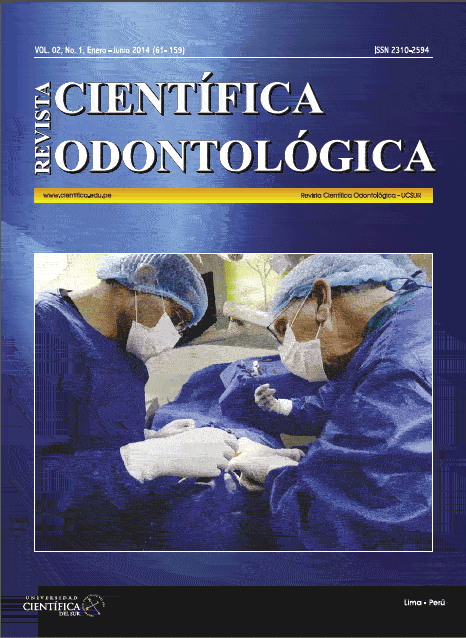Análisis de tensiones con el método de elemento finito a nivel de la interfase hueso - implante de un nuevo diseño de conexión interna: Octodecágono.
DOI:
https://doi.org/10.21142/2523-2754-0201-2014-%25pPalabras clave:
Implantes Dentales, Biomecánica, Pilares Dentales, Programas InformáticosResumen
RESUMEN
Los fracasos de los implantes producidos después de la carga funcional están principalmente relacionados a factores
biomecánicos. Diversos análisis han demostrado que el macro diseño del implante y el tipo de conexión pueden afectar la
transmisión de fuerza al hueso peri-implantar.
OBJETIVO: Evaluar la distribución de tensiones en el hueso y el implante ante una fuerzas horizontales y verticales en
tres diseños de implante de conexión interna: Octodecágono, hexágono interno y cono morse; por medio de análisis en
elementos finitos (MEF).
MATERIALES Y MÉTODOS: Los tres diseños de conexión interna tuvieron aplicación de fuerza horizontal y vertical del
150N. El modelado geométrico de los sistemas de implantes se realizó con el software Solid Works 2011. Se obtuvieron
resultados mediante el análisis de Von Mises a través del programa Cosmo Works.
RESULTADOS: El menor valor de máxima tensión a nivel óseo, ante fuerzas verticales y horizontales, se encontró en el
(MEF 1) octodecágono y a nivel del implante en el (MEF 3) cono morse. Para el implante la tensión máxima se halló en el
hexágono interno.
CONCLUSIÓN: El diseño de tipo conexión octodecagonal genera menores tensiones a nivel óseo y del implante ante
fuerzas horizontales y verticales, distribuyendo mejor las cargas a este nivel. También se observó que la conexión cono
morse genera menor tensión a nivel cervical en el implante, ante fuerzas verticales y horizontales.
Descargas
Referencias
Schwarz F, Herten M, Bieling K, Becker J. Crestal Bone Changes at Non submerged Implants (Camlog) with Different Machined Collar Lengths: A Histomorphometric Pilot Study in Dogs. International
Journal of Oral & Maxillofacial Implants. 2008; 23(2): 335-42.
Bechelli A. Carga inmediata en Implantología Oral. Buenos Aires: Editorial Providence; 2003.
McNeill C. Fundamentos científicos y aplicaciones prácticas de la oclusión. Barcelona: Editorial Quintessence; 2005.
Misch C. Implantología Contemporánea. Madrid:Editorial Mosby; 1995.
Karl M, Winter W, Taylor TD, Heckmann SM. In Vitro Study on Passive Fit in Implant Supported 5-unit fixed partial dentures. Int J Oral Maxillofac Implants. 2004; 19:30–7.
Vasudeva G, Bogra P. The effect of occlusal restora-Universidad Científica del Sur Revista Científica Odontológica. 2014;2:127 -135
Recibido: 05 -12 -13 Aceptado: 19 -01 -14 Autor principal: Brenda Franco Silva Correspondencia: brendafs22@hotmail.com
tion and loading on the development of ab-fraction lesions: A finite element study. International Journal of Conservative Dentistry. 2008; 11(3): 117–20.
Babbush CH, Hanh J, Krauser J, Rosenlicht J. Implantes dentales. Arte y ciencia. Venezuela: Editorial Amolca 2. ed.2012
Cai K, Zhang H, Luo Y, Chen B. [Wolff´s law based continuum topology optimization method and its application in biomechanicas.]Sheng Wu Yi Xue Gong Cheng 25(2):331-335,2008.
Chun HJ, Cheong YS, Han JH. Evaluation of design parameters of osseointegrated dental implants using finite element analysis. J Oral Rehabil. 2002;29:565-71.
Geng JP, Tan KB, Liu GR. Application of finite element analysis in implant dentistry: a review of the literature. J Prosthet Dent 2001;85:585-98.
Holmgren EP, Seckinger RJ, Kilgren LM, Mante F. Evaluating parameters of osseointegrated dental implants using finite element analysis a two-dimensional comparative study examining the effects of implant diameter, implant shape, and load direction. J Oral Implantol
;24:80-8.
Ferreira JJ, Pizza E, Falcon Antenucci RM, Dantas SL, Machado B. Implantes tipo plataforma modificada: Revisión de literatura. Acta Odontológica Venezolana. 2010;49(3).56-59.
Geng JP, Tan KB, Liu GR. Application of finite element analysis in implant dentistry: A review of the literature. J Prosthet Dent 2001;85:585-98.
Holmgren EP, Seckinger RJ, Kilgren LM, Mante F. Evaluating parameters of osseointegrated dental implants using finite element analysis a two-dimensional comparative study examining the effects of implant diameter, implant shape, and load direction. J Oral Implantol
;24:80-8.
Stegaroiu R, Sato T, Kusakari H, Miyakawa 0. Influence of restoration type on stress distribution in bone around implants: a three-dimensional finite element analysis. Int J Oral Maxillofac implants. 1998;13:82-90.
Stegaroiu R, Kusakari H, Nishiyama S, Miyakawa 0. Influence of prosthesis material on stress distribution in bone andimplant: a 3-dimensional finite element analysis. Int J Oral Maxillofac implants.
;13:781-790.
Cimen H, Yengin E. Analyzing the Effects of the Platform-Switching Procedure on Stresses in the Implant-Abutment Complex by 3-Dimensional Fem Analysis. Journal of Oral Implantology. 2012;38:21-6.
Maran M, Chan H, Wang H. Effect of the Platform-Switching Technique on Preservation of Peri-implant Marginal Bone: A Systematic Review. The International Journal of Oral & Maxillofacial Implants.2012;27:138-45.
Coppedê A, Bersani E, de Mattos M, Rodrigues R, de Mattias Sartori I, Ribeiro R. Fracture Re-sistance of the Implant-Abutment Connection in Implants with Internal Hex and Internal Conical Connections
Under Oblique Compressive Loading: An In Vitro Study. International Journal of Prosthodontics.2009; 22(3): 283-86.
Quaresma S, Cury P, Sendyk W, Sendyk C. A finite element analysis of two different dental implants: stress distribution in the prosthesis, abutment, implant, and supporting bone. International Journal of Implantology. 2008; 24(1): 1-6.
Balik A, Ozdemir M, Keskin H. Effect of different connection designs on the stress distribution around five different implants: A 3 - dimensional finite element analysis. Journal of Oral Implantology.
;38:491-96.
Chun HJ, Shin HS, Han CH, Lee SH. Influence of implant abutment type on stress distribution in bone under various loading conditions using finite element analysis. Int J Oral Max Impl 2006; 21: 195-202.
Maeda Y, Miura J, Taki I, Sogo M. Biomechanical analysis on platform switching: is there any biomechanical rationale? Clin Oral Implants Res. 2007;18:581-4.
Sutter F, Weber H, Sorenson J, Belser U. The new restorative
concept of the ITI dental implant system: design and engineering. International Journal of Periodontics & Restorative Dentistry. 1993; 13:408-431.
Akca K, Cehreli M. A Comparison of Three Dimensional Finite Element Stress Analysis with In Vitro Strain Gauge Measurements on Dental Implants. International Journal of Periodontics & Restorative
Dentistry. 2008; 28(4): 391-99.
Descargas
Publicado
Número
Sección
Licencia

Este obra está bajo una licencia de Creative Commons Reconocimiento 4.0 Internacional.












